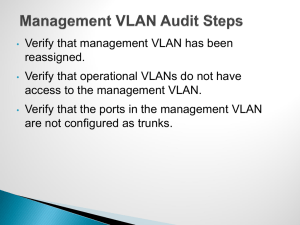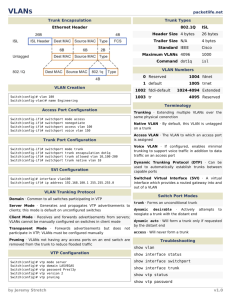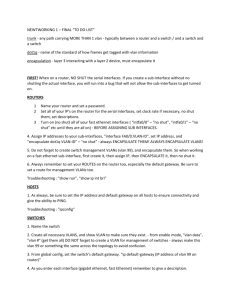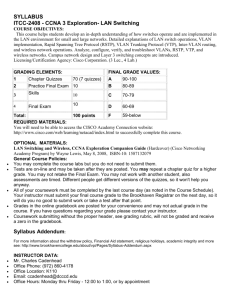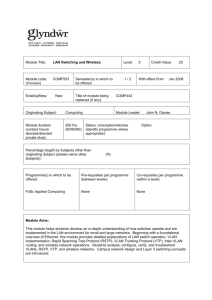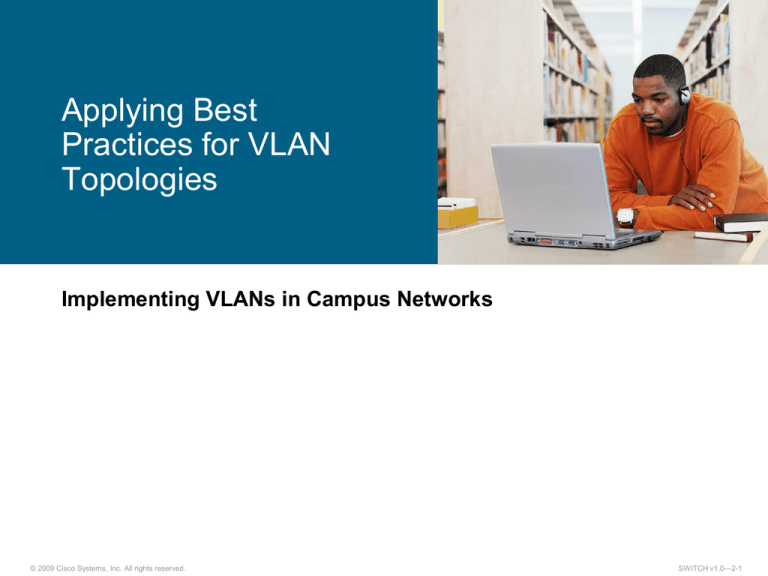
Applying Best
Practices for VLAN
Topologies
Implementing VLANs in Campus Networks
© 2009 Cisco Systems, Inc. All rights reserved.
SWITCH v1.0—2-1
VLAN Deployment
End-to-End VLANs
Users are grouped into
VLANs independent of
physical location.
If users are moved within
the campus, their VLAN
membership remains the
same.
Local VLANs
This is the recommended
solution in the Cisco
Enterprise Campus
Architecture.
Users are grouped into
VLANs depending on
physical location.
If users are moved within
the campus, their VLAN
membership changes.
© 2009 Cisco Systems, Inc. All rights reserved.
SWITCH v1.0—2-2
End-to-End VLANs vs. Local VLANs
End-to-End VLANs
Pros:
Geographically dispersed users
appear on the same segment.
Same policy (security, QoS) can be
applied to the same group of users
regardless of their physical location.
Cons
All switches need to know all VLANs.
Broadcast messages flood all
switches.
Local VLANs
Pros:
Design is scalable.
Troubleshooting is easy.
Traffic flow is predictable.
Redundant paths can be built easily.
Cons
More routing devices are required
than in end-to-end models.
Users belong to the same broadcast
domain when they are at the same
location.
Troubleshooting may be challenging.
The end-to-end VLANs design model was attractive
when IP addressing was static and network traffic
followed the 80/20 rule.
© 2009 Cisco Systems, Inc. All rights reserved.
SWITCH v1.0—2-3
Planning an End-to-End VLAN
Implementation
Basic tasks:
How many IP subnets (data, voice, etc.)?
Gather VLAN numbers, names, and uses.
Gather VLAN-to-IP mapping.
Local VLANs (recommended) or end-to-end VLANs?
Where is each VLAN needed in the campus?
How are VLANs assigned?
Are trunks necessary?
Will VTP be used (not recommended)?
Create the test plan.
© 2009 Cisco Systems, Inc. All rights reserved.
SWITCH v1.0—2-4
VLAN Configuration
Configure VLANs on all switches.
Configure access mode on port.
Configure access VLAN on port.
© 2009 Cisco Systems, Inc. All rights reserved.
SWITCH v1.0—2-5
Verifying the VLAN Configuration
Switch# show vlan
VLAN
---1
2
3
99
1002
1003
1004
1005
Name
-------------------------------default
Marketing
Accounting
VLAN0099
fddi-default
token-ring-default
fddinet-default
trnet-default
VLAN
---1
2
3
99
Type
----enet
enet
enet
enet
SAID
---------100001
100002
100003
100003
© 2009 Cisco Systems, Inc. All rights reserved.
MTU
----1500
1500
1500
1500
Parent
------
Status
--------active
active
active
active
act/unsup
act/unsup
act/unsup
act/unsup
RingNo
------
Ports
-----------------------------Fa0/2, Fa0/5
Fa0/1, Fa0/4
BridgeNo
--------
Stp
----
BrdgMode
--------
Trans1
-----0
0
0
0
Trans2
-----0
0
0
0
SWITCH v1.0—2-6
Trunk Configuration
Configure VLANs.
Disable trunk negotiation.
Configure trunk mode.
Set native VLAN to unused
VLAN.
Allow only required VLANs on
trunks.
switch(config)# vlan 5,7-9
switch(config-vlan)# exit
switch(config)# interface fastethernet 0/1
switch(config-if)# shutdown
switch(config-if)# switchport trunk encapsulation dot1q
switch(config-if)# switchport nonegotiate
switch(config-if)# switchport mode trunk
switch(config-if)# switchport trunk native vlan 99
switch(config-if)# switchport trunk allowed vlan 3,5,8,99
switch(config-if)# no shutdown
© 2009 Cisco Systems, Inc. All rights reserved.
SWITCH v1.0—2-7
Switchport Mode Interactions
Configure the port as trunk or access on both switches.
Disable negotiation and do not use dynamic (default).
Manual configuration is recommended.
Dynamic
Auto
Dynamic
Desirable
Trunk
Access
© 2009 Cisco Systems, Inc. All rights reserved.
Dynamic
Auto
Dynamic
Desirable
Trunk
Access
Access
Trunk
Trunk
Access
Trunk
Trunk
Trunk
Access
Trunk
Trunk
Trunk
Limited
connectivity
Access
Access
Limited
connectivity
Access
SWITCH v1.0—2-8
Trunk Configuration Recommendations
Configure VLANs.
Configure trunk mode.
Disable trunk negotiation.
Manually remove unnecessary VLANs from trunks.
Configure native VLAN to unused VLAN.
Disable trunking on host ports.
Do not use VTP.
© 2009 Cisco Systems, Inc. All rights reserved.
SWITCH v1.0—2-9
VTP Configuration
Configure VTP mode transparent (mode server is default).
VLAN information is stored in switch configuration.
No VTP advertisment to other switches.
Recommended configuration.
switch(config)# vtp mode transparent
switch(config)# vtp domain Cisco
switch(config)# vtp password xyz123
© 2009 Cisco Systems, Inc. All rights reserved.
SWITCH v1.0—2-10
Verifying the VTP Configuration
Switch# show vtp status
VTP Version
: running VTP1 (VTP2 capable)
Configuration Revision
: 0
Maximum VLANs supported locally : 1005
Number of existing VLANs
: 15
VTP Operating Mode
: Transparent
VTP Domain Name
: XYZ
VTP Pruning Mode
: Disabled
VTP V2 Mode
: Disabled
VTP Traps Generation
: Disabled
MD5 digest
: 0x56 0x8B 0x47 0x72 0x63 0xE4 0x6B
Configuration last modified by 0.0.0.0 at 0-0-00 00:00:00
© 2009 Cisco Systems, Inc. All rights reserved.
SWITCH v1.0—2-11
Common Problems with VTP
Configuration
Missing VLANs
– Configuration has been overwritten by another VTP device.
Updates not received as expected
– VTP domain and password must match.
Too many VLANs
– Consider making VTP domain smaller.
© 2009 Cisco Systems, Inc. All rights reserved.
SWITCH v1.0—2-12
Verifying General VLAN Operations
© 2009 Cisco Systems, Inc. All rights reserved.
SWITCH v1.0—2-13
Common Trunk Link Problems
Trunks can be configured statically or autonegotiated with DTP.
For trunking to be autonegotiated, the switches must be in the same VTP
domain.
Some trunk configuration combinations will successfully configure a
trunk, and some will not.
Will any of the above combinations result in an operational trunk?
© 2009 Cisco Systems, Inc. All rights reserved.
SWITCH v1.0—2-14
Example of a Troubleshooting Process
Original implementation plan: Create new VLAN for new
class of users.
Create VLAN.
– Was the VLAN added to all switches?
– Is it manually pruned somewhere?
Add new users to ports.
– Is the correct VLAN configured on the port?
– Is the port enabled?
– Is it enabled as a switch port?
Verify connectivity.
– Are all links set to trunk?
– Is the VLAN allowed on all trunks?
– Is spanning tree blocking a link?
© 2009 Cisco Systems, Inc. All rights reserved.
SWITCH v1.0—2-15
Resolving Trunk Link Problems
When using DTP, ensure that both ends of the link are in the
same VTP domain.
Ensure that the trunk encapsulation type configured on both ends
of the link is valid.
On links where trunking is not required, DTP should be turned off.
The best practice is to configure the trunk with nonegotiate
where trunks are required.
© 2009 Cisco Systems, Inc. All rights reserved.
SWITCH v1.0—2-16
Issues with 802.1Q Native VLAN
Native VLAN frames are carried over the trunk link untagged.
Native VLAN must match at the ends of a trunk.
A native VLAN mismatch will merge traffic between VLANs.
Default native VLAN is VLAN 1.
Configure an unused VLAN as native VLAN on trunks.
© 2009 Cisco Systems, Inc. All rights reserved.
SWITCH v1.0—2-17
Summary
VLAN segmentation is based on traffic flow patterns.
The creation of a VLAN implementation plan depends on the
business and technical requirements.
VLAN configuration includes creating the VLAN, configuring
access ports, and configuring trunk ports.
VTP configuration sometimes needs to be added to small network
deployments, while VTP transparent mode is usually privileged for
larger networks.
When configuring VLANs over several switches, ensure that the
configuration is compatible throughout switches in the same
domain.
© 2009 Cisco Systems, Inc. All rights reserved.
SWITCH v1.0—2-18
© 2009 Cisco Systems, Inc. All rights reserved.
SWITCH v1.0—2-19


